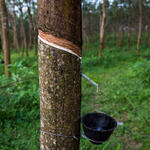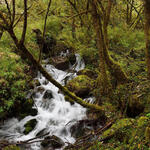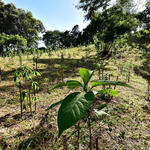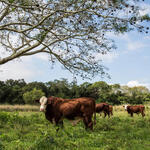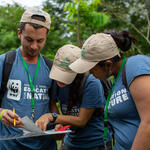- Date: 16 December 2021
- Author: Amy Smith, Director, Forests, Sustainable Natural Rubber, WWF
Major commodity sectors, such as palm oil and pulp and paper, have been tackling sustainability and deforestation challenges for decades. The natural rubber sector is newer to the sustainability race. It only started addressing these issues over the last five years.
Despite the opportunity to learn from other sectors, the natural rubber sector still lags far behind in supply chain transparency and sustainability. While there’s been some recent progress, we are calling on industry leaders to fully join the race. They must disclose where their rubber comes from and the conditions under which it’s produced.
- Date: 26 October 2021
- Author: Linda Walker, Senior Director, Corporate Engagement, Forests
Today, HP announced an $80 million expansion of its forest conservation partnership with WWF to help restore, protect, and improve the management of nearly 1 million acres of forest around the world by 2030. With this next step in our decades-long relationship, HP now becomes WWF’s largest U.S. corporate partner.
There is an urgent need for business leaders to set and implement rigorous nature and climate targets and to meet them by investing in high-integrity nature-based solutions that put people and communities at the center. This move from HP raises the bar for what leadership looks like for corporate climate and nature commitments. As part of the company’s sustainability and climate strategy, HP is pledging to address the downstream impacts of its business on nature by taking action for forests at a level that considers all the paper that runs through its printers and print services by 2030, even if it’s not HP branded.
- Date: 26 October 2021
- Author: Anneliese Olson, HP Inc.
Here’s a challenge for you: Reflect on the places where you experienced life’s simplest pleasures. Do you imagine the scenic hike you took to get some steps in for the day? That park you took your kids to every Saturday morning? Or maybe even your own backyard?
It’s impossible for me to imagine being in any of my favorite places without trees, but beyond my personal enjoyment, forests are so important because they are home to three-quarters of the planet’s life on land and provide clean air and water. Forests are simply the best nature-based solution to address the climate crisis, and we must do what we can to protect them.
I’m fortunate to work at a company that understands the true value of forests both to its business and in the fight against climate change and knows the best way to make real impact is through partnership. HP Inc. and World Wildlife Fund (WWF) have been working together for over a decade to ensure that we are sourcing our paper products responsibly. Partnerships like this have helped HP reach many environmental milestones. HP brand paper has been deforestation-free since 2016, and in 2020, HP achieved zero deforestation for 99% of HP paper-based product packaging with the remaining 1% assessed to ensure reported fiber usage meets HP’s Sustainable Paper and Wood Policy.[i]
In 2019, HP and WWF joined forces to go beyond our sourcing and broaden our conservation efforts to help safeguard global forest ecosystems. In the past two years, we’ve been collaborating to restore part of Brazil's threatened Atlantic Forest and increase sustainable management of state-owned forest farms in China—with the aim of protecting a combined area of over 200,000 acres.
Brazil’s Atlantic Forest is a biodiversity hot spot, home to iconic wildlife like the jaguar and 7% of Earth’s plant species. But it has lost more than 83% of its original area. Partnering with landowners and local groups, WWF and HP are helping to restore critical areas of the Atlantic Forest. Since 2019, together we have engaged over 50 local institutions and 150 community stakeholders in the Serra do Mar, Mogi Guaçu, and Upper Paraná regions to secure their participation in forest restoration activities.
In China, WWF and HP are working with forest agencies and forest owners to pursue Forest Stewardship Council® (FSC®) certification under the new FSC-China national standard across 220,000 acres. China is one of the largest producers of paper products, yet it relies heavily on imported wood to meet demand, much of which comes from countries with high risk of deforestation. Improving forest management in China can help reduce pressure on threatened and high value forests. The partnership is providing training and technical support to forest managers of 462,000 acres of forestland to help improve forest management practices and enable the long-term success of FSC certification.
Ahead of the UN Climate Change Conference (COP26) this year, we announced a partnership expansion with WWF to counterbalance the amount of paper, regardless of brand, used in HP printers by conserving an equivalent number of forest resources.[ii] This builds on HP’s support of WWF’s development of science-based targets for forests. HP will be the first company to pilot a new methodology developed by WWF as part of its work on science-based targets for forests to more comprehensively estimate the impact on forests from non-HP paper that runs through HP printers globally. And then HP and WWF will protect, restore, and improve the management of a requisite amount of forests. By doing so, HP is helping to ensure nature-based solutions are informed by the best available science and protect the co-benefits forest ecosystems provide for people, plants and animals. As part of this partnership expansion, WWF is also joining HP’s Sustainable Forest Collaborative, a cross-industry collaboration we launched in 2019 to demonstrate scientific and commercially viable approaches to keep working forest ecosystems healthy.
For over a decade, our work with WWF and partners has helped us drive lasting, positive impact for the business and the planet. We’re proud and excited for the next decade of working alongside WWF to make a forest positive future a reality.
[i] In 2020, 99% of HP brand paper and paper-based product packaging were derived from certified or recycled sources. Packaging is defined as the box that comes with the product and all paper-based materials inside the box.
[ii] Fiber by weight will be 1) certified to rigorous third-party standards, 2) recycled, or 3) balanced by forest restoration, protection, and other initiatives through HP’s Forest Positive Framework. Paper does not include fiber-based substrates for HP industrial presses not listed in HP Media Solutions Locator catalogues.
The views expressed in this post do not necessarily reflect those of WWF.
- Date: 14 July 2021
- Author: Christa Anderson and Martha Stevenson, World Wildlife Fund
Nature-Based Solutions in Science-Based Targets
Many companies strive to include Nature-Based Solutions (NBS) in their climate strategies within the Science Based Targets initiative (SBTi).1 When done right, NBS for climate mitigation are a genuine win-win. Companies deliver on their climate goals and simultaneously support nature and address societal challenges. Here we provide a brief outline of how NBS fit into Science-Based Targets and what’s coming soon.
- Date: 13 July 2021
- Author: Karla Canavan, VP, Commodity Trade and Finance, Katherine Devine, Director of Business Case Development, WWF
Before net-zero commitments became all the rage, companies were pledging to eliminate deforestation from their supply chains. Deforestation and habitat conversion are powerful contributors to climate change, accounting for about 15% or more of global GHG emissions. Despite increasing numbers of commitments and a decade of effort in some cases, companies have struggled to achieve them. It’s not surprising; there are many complex issues in supply chains that could contribute to deforestation and conversion. These range from multiple direct and indirect suppliers, lack of traceability, lack of government support, fluctuating market forces—such as increasing global demand from China, and more. Nevertheless, addressing the challenge of taking deforestation and conversion out of global supply chains (Deforestation- and Conversion-Free, or DCF) can not wait.
- Date: 10 June 2021
A Q&A with Linda Walker, Senior Director of Corporate Engagement for Forests, World Wildlife Fund
What is Forests Forward?
Forests Forward is a new WWF corporate program that engages companies around the world to help them reduce their forest footprint and support other on-the-ground actions—like forest restoration—to keep forests thriving for people, nature and climate.
The program is a one-stop shop for companies looking to implement best practices around nature-based solutions to deliver on their sustainability and business goals. Drawing on our deep expertise in forests, science and climate, WWF works with companies on both long-term and near-term strategies and collaborations that have lasting benefits—not only for the companies but also for local communities.
- Date: 20 October 2020
- Author: Kerry Cesareo, Senior Vice President, Forests, World Wildlife Fund
Clearer public-private pathways are putting us on the right track
The end of 2020 marks a crossroads that is both deeply worrying and quite exciting. Deforestation and conversion of natural ecosystems continue unabated, with 3.8 million hectares of tropical primary forest lost in 2019—a 2.8% increase from the previous year. Wildfires rage from the Amazon to the Arctic, and the recent Living Planet Report released by World Wildlife Fund (WWF) shows an average 68% decrease in population sizes of mammals, birds, amphibians, reptiles, and fish in less than 50 years. Deforestation is enabling more human-animal contact and raising the chances of new pandemics spilling over to humans; it also continues to be a primary driver of climate change, creating a vicious cycle.
Concurrently, conservation and restoration of forests, and nature more broadly, have been elevated on the global agenda. Forests are included in the Paris Agreement and in the land-based carbon targets of many countries’ Nationally Determined Contributions. And, building from the experiences of REDD+, governments at the national and subnational level in many key commodity-producing regions are translating these ambitions into action by providing leadership in place-based, multistakeholder efforts to address deforestation and conversion. Increasingly, governments and the business community are engaging with each other. Ghana, for instance, has created action plans with cocoa buyers to address deforestation. In Indonesia, the National Action Plan for Sustainable Palm Oil is providing a structure around which palm oil companies can coordinate their forest protection and restoration efforts in line with government strategies.
Meanwhile, the business case for far more expansive action to protect nature has become obvious. Nature loss is no longer just an issue of reputational risk—it threatens the future of commodity supply and the jobs linked with raw material production. Forest loss is damaging soil quality while changing weather patterns are reducing yields of planted crops. The World Economic Forum’s Global Risks Report 2020 ranked biodiversity loss and ecosystem collapse among the top five threats the global economy will face in the next 10 years.
The private sector has taken notice and begun to evolve its sustainability ambitions to match the scale of the challenge confronting nature. Over the last decade, much of the business community committed to eliminate deforestation from its commodity sourcing, and the Accountability Framework initiative (AFi) and Collaboration for Forests and Agriculture (CFA) have created best-practice guidance to support implementation. More recently, leading companies have begun to align with government and other actors in producing regions on strategies that go beyond individual supply chains to address underlying drivers of nature loss. Several important platforms like the Consumer Goods Forum and Tropical Forest Alliance (TFA) are helping to mainstream expectations that the public and private sectors should collaborate through landscape and jurisdictional initiatives.
This trend is encouraging, but the overall number of companies engaging in these scaled efforts remains low. Major barriers have included uncertainty around the business case for multistakeholder collaboration and a dearth of clear examples to follow. There is also misalignment between the sort of actions civil society is asking companies to undertake and the sustainability practices for which companies are currently recognized and rewarded.
But barriers to engagement are coming down. Over the past year, a group of organizations has developed a suite of new tools and guidance to enable broader company engagement in production geographies where they are invested or exposed. Whereas AFi and CFA provide the key guidance for implementing deforestation/conversion-free commitments within supply chains, these new tools elaborate complementary guidance for addressing systemic drivers. They pull from concrete examples to help companies understand and navigate through their options to engage. And thoughtful collaborations have positioned these tools to be reasonably aligned, thus avoiding the pitfalls of conflicting guidance from civil society.
- A new paper from the United Nations Development Program, Value Beyond Value Chains, clarifies why and broadly how companies can engage in landscape and jurisdictional initiatives. It explains the business case for collaborating beyond value chains at landscape, subnational, and national levels to help create the enabling conditions for sustainable production and provides broad schemas to help companies think about how to engage in multistakeholder initiatives in producer countries.
- A complementary paper from Proforest, Engaging with Landscape Initiatives, fleshes out the how and adds guidance on where to engage. It walks through steps companies should take when thinking about how to engage in landscapes, describing elements of the engagement process like building trust, planning and implementing interventions, and monitoring of progress. And it helps companies understand their supply base, how to prioritize landscapes for engagement, and decide which initiatives they might work with.
- A resource that Walmart recently launched provides more granularity on the question of where to engage, providing maps that show the jurisdictions where companies are likeliest to source key deforestation-risk commodities and the deforestation risk of these jurisdictions.
- Building on these tools, TFA released a set of corporate guidance and a dynamic web-based tool developed by WWF and Proforest that goes the next step in describing what specific actions companies can implement to advance landscape and jurisdictional initiatives. It provides concrete interventions companies can take, offers real-world examples where companies are already doing so, and proposes guidance on how to execute.
- Each of the previous tools informs corporate action. New guidance from ISEAL Alliance on Verification of Jurisdictional Claims lays out the parameters for assuring progress at the landscape/jurisdictional scale and for making credible claims about contributions toward that progress. It walks through practical steps to ensure the integrity of landscape-level performance data and how progress is communicated, and it explores the types of claims companies can make depending on the ways they engage.
While time is running out to reverse global ecosystem loss, we’re finally at a point where governments and companies are beginning to mobilize at the scale required to meet our conservation imperatives. Thanks to this new guidance, the pathways for corporate action are clearer than ever. Now, with these tools in hand, the moment has come for public-private partners to accelerate their joint efforts—for the future of the natural world and generations to come.
- Date: 17 July 2020
As our society faces many uncertainties, one thing has never been more clear – investing in the health of our planet provides a foundation to build resilient communities for both people and nature. Many companies are at the forefront of driving innovation and developing strategies that help our global community tackle challenges, including climate change. For years most sustainability strategies existed within a company’s four walls, but as we settle into a new decade, companies are starting to embrace nature-based solutions to deliver impactful results that help propel us toward a carbon neutral future.
Recently, P&G announced a new project with WWF to advance restoration in Brazil’s Atlantic Forest, which is part of a larger commitment for its operations to be carbon neutral for the next decade. To better understand what these investments in nature really mean, we asked WWF’s Sheila Bonini, senior vice president for private sector engagement, and Kerry Cesareo, senior vice president for forests, to help break it down:
- Date: 11 March 2020
- Author: Lisa Frank
At Lisa Frank Inc, nature is one of our greatest inspirations, which shouldn't come as a surprise to anyone. We produce art filled with adorable creatures and vivid colors to celebrate animals and wildlife. There's a special feeling of joy and awe that fills you up when you think of the majestic creatures that roam our planet. That feeling is what Lisa Frank always tries to capture with our designs.
For animal lovers, including so many of the Lisa Frank fans and followers, the past several months have been incredibly tough. The wildfires in Australia were so widespread and so devastating. The terrible toll these fires have taken on people, animals, and nature, is almost too much to bear. But even in the face of something so horrible, we can't give in to feelings of hopelessness. While most of us may not be firefighters or environmental scientists, every single one of us can do something to help.
In Lisa Frank's case, that means using the power of our designs and the reach of our business to raise funds for World Wildlife Fund to help with restoration and recovery efforts in Australia. We also want to give the Lisa Frank audience, especially our youngest fans, an easy way they can contribute and help make a difference.
To support this important cause, we issued a collection called, "I heart; Koalas." It's a design in classic Lisa Frank style, full of whimsy, color, and joy. While our motivations for starting this campaign are heartbreaking, we deliberately wanted to use an image that would give our fans that same warm, fuzzy Lisa Frank feeling. Our design reminds people why they care about wildlife, sparking them to contribute to the effort out of joy, love, and hope, not out of fear or sadness.
While the reality for wildlife on our planet isn't always sunshine and rainbows, it's so important that we continue to celebrate the love we have for nature, focusing on what we can save and restore, rather than what we've lost. This attitude is shared by World Wildlife Fund, which is why we're so excited to support them through this project. We want Lisa Frank's fans to know that there's a role for everyone to help, both with the recovery effort in Australia and with conservation around the world. Any individual -- and any business, including ours -- can do their part. And together by showing how much we care about wildlife, each of our efforts can add up to something incredible.
- Date: 30 January 2020
- Author: Erin Knight
Right now, tropical forest regions are under immense pressure to provide services for people and wildlife. Balancing competing demands for land use is a challenging undertaking that requires dedication and buy-in from a variety of stakeholders and local actors. To encourage and accelerate forest restoration efforts, several global initiatives have been developed, such as the African Forest Landscape Restoration Initiative (AFR100), the Bonn Challenge, Initiative 20x20, and most recently, the UN's Decade on Ecosystem Restoration.
